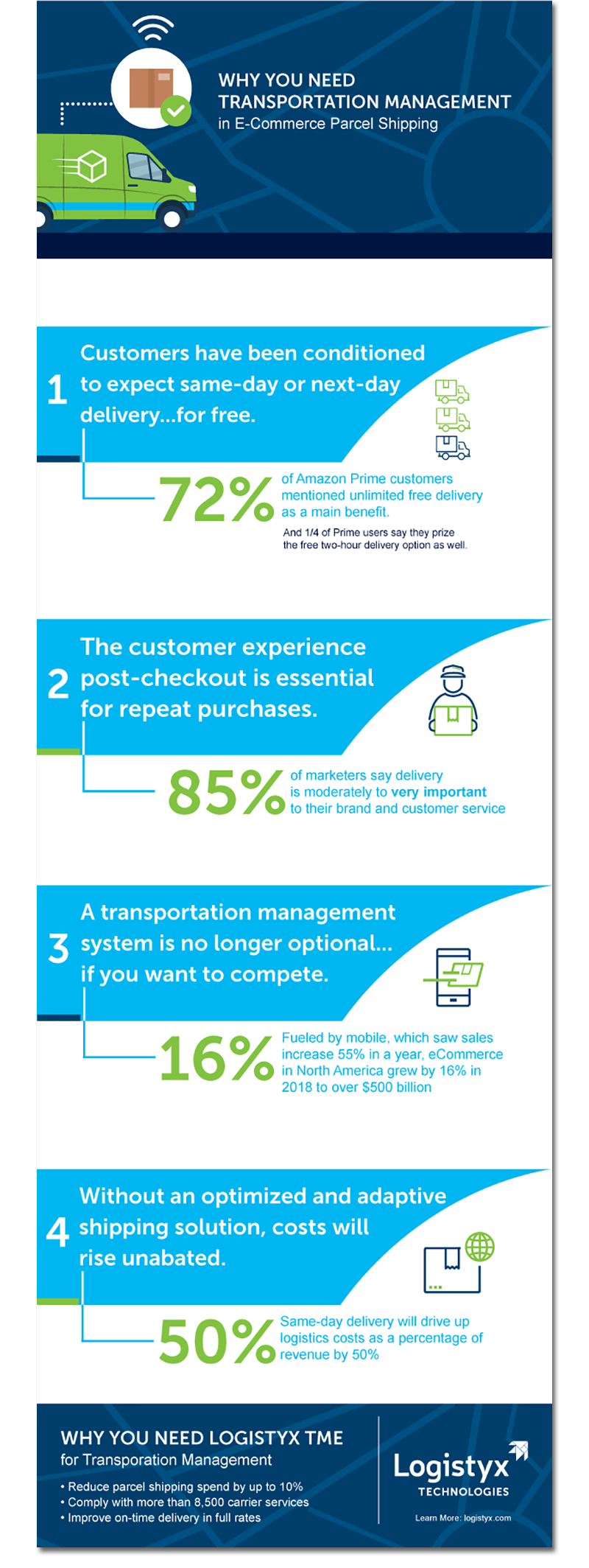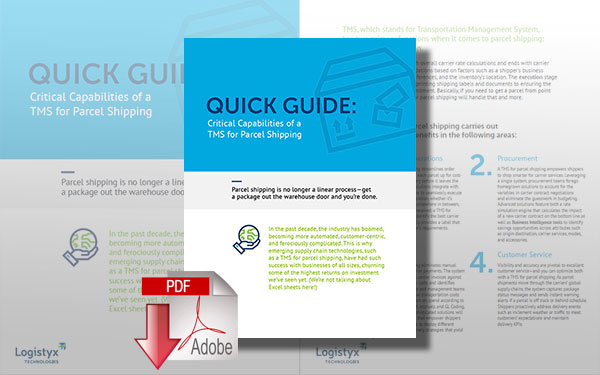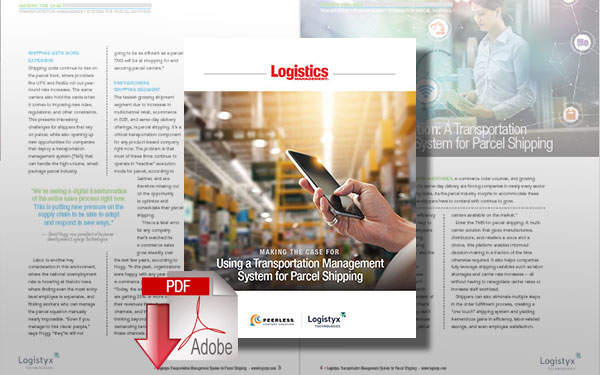The Power of Transportation Management in E-Commerce Parcel Shipping

Customers have been conditioned by popular e-tailers such as Amazon and Alibaba to expect same-day/next day delivery, and it doesn’t seem likely these expectations will lessen any time soon.
Companies racing to leverage e-commerce opportunities may suddenly find themselves shipping internationally – and at high volumes.
To do so successfully means simultaneously:
- Juggling multiple carriers and services
- Quickly synthesizing shipping data from disparate sources
- Managing increasingly complex cross-border documentation
- Monitoring parcel delivery events worldwide, and accelerating the speed at which these events are communicated to customers
This is no easy feat – although e-commerce creates seemingly infinite sales opportunities, it also introduces new pressures that many organizations aren’t equipped to handle.
Speed is the New Currency
Customers have been conditioned by popular e-tailers such as Amazon and Alibaba to expect same-day/next day delivery. And it doesn’t seem likely these expectations will lessen any time soon. On the contrary, they may actually increase.
In its 2018 Global Consumer Insights Survey, PwC asked approximately 22,000 shoppers worldwide to weigh in on their shipping preferences – from deliveries to returns.
Survey results revealed for one-third of those Amazon customers who use the company’s Prime service, the most important benefit cited was unlimited free delivery (mentioned by 72% of Prime users), and one-quarter of Prime users say they prize Prime’s free two-hour delivery option as well.
Shipping Parcels Globally Creates a Complex Logistics Ecosystem
While geographic boundaries may have shrunk, crossing these boundaries requires shippers to navigate a labyrinth of local couriers, paperwork, tariffs, and customs – and if a shipment includes a high value or hazardous item, the process is even more elaborate.
Add consumer expectations for same-day/next day delivery to the mix, and organizations are suddenly under tremendous pressure to flawlessly navigate cross-border shipping while eliminating any chance of a shipment being held up at customs.

Customer Expectations
Customer expectations are high and evolving, created and re-created daily as they encounter highly satisfying experiences from product discovery to product delivery. According to a new report from project44, 85% of marketers now say delivery is moderately to very important to their brand and customer experience.
“Whether it is ordering dinner via Grubhub, curbside pick-up for household items at Walmart, or Amazon Fresh’s store-to-door grocery delivery, companies are increasingly expanding their offerings to include services that bring products directly to consumers.”
This means that for retail shippers, working on the customer experience post-checkout is essential for repeat purchases.
Omnichannel Complications
Omnichannel order fulfillment complicates parcel shipping workstreams, as companies move inventory from distribution center (DC) to store, from store to store, from store to consumer, from DC to consumer, and more – all in parallel. While omnichannel distribution can improve sales, customer service, merchandising initiatives, and more if implemented effectively, there are disadvantages.
For example, using retail stores as fulfillment centers can create major challenges for in-store productivity/profitability, customer service, and staff retention, and as retailers decentralize shipping operations and access inventory in stores, this creates “order fragmentation” and increases costs.

Siloed Operations
Transportation teams often operate in a silo, and decision making becomes flawed. While larger organizations may be disciplined with data strategies and use of business intelligence, small organizations may be so focused on buzz words like ‘big data’ that they have overlooked the importance of ‘right data.’ Management may not fully realize the value of business intelligence, or they may feel overwhelmed when they understand they lack key informational insights or have data trapped in silos.
With all of these pressures, it’s no wonder organizations struggle to seamlessly execute end-to-end e-commerce shipping. And as long as shipping processes remain manual and disconnected from larger enterprise systems, shipping data will continue to be siloed and leadership will be left flying blind—with no way to plan, execute, and measure their parcel shipping operations at a strategic level.
While it may feel like a daunting task, getting up to speed – and continuing to maintain pace – with the e-commerce market is no longer optional. Fueled by mobile, which saw sales increase 55% in a year, eCommerce in North America grew by 16% in 2018 to over $500 billion. The urgency and the opportunity to work differently has arrived.
What Not to Do
Many organizations are acutely aware of the pressures that come with e-commerce parcel shipping, but their attempts to address it continue to be tactical, rather than strategic. They roll out various productivity initiatives in the warehouse, they increase the number of carrier workstations on the warehouse floor, or they retrofit existing platforms – all the while thinking, “Well, this has worked for us before.”
These initiatives inevitably fail because the tools and technology weren’t built for the demands of e-commerce order fulfillment and the reality of how people and companies must work in today’s shipping environment. In the world of modern shipping, surviving and thriving requires bold, new steps.
A Bold, New (Necessary) Way
A Transportation Management System (TMS) for parcel shipping enables organizations to transform e-commerce shipping processes – optimizing, connecting, and adapting the way transportation teams work so shipping volumes, and success, can quickly scale.
How? By helping teams save money, time, and labor in shipping. It can also solve many issues within fulfillment ops, procurement, finance, and customer service.
Think of a TMS for parcel shipping as a crucial vertebrae in the supply chain backbone. It connects to all other systems and tools in a boundaryless way, allowing organizations to start small and grow across the enterprise when ready.
It helps supply chains move at a new pace by uniting end-to-end shipping tasks and data, which in turn allows fulfillment, procurement, and customer service teams to focus. Suddenly, organizations can:
- Leverage a single system to manage carrier contracts, comply with label and documentation requirements, and see the long-term impact of various carrier service rates – while also increasing capacity to identify new carrier services and on-board them quickly
- Integrate parcel shipping with other supply chain solutions, such as ERP, WMS, and OMS to create one ecosystem, so to speak, for the entire shipment lifecycle
- Centralize all parcel shipping data (i.e., shipment volumes, cost variables, delivery events) and run data analytics and reports to gain visibility and improve decision-making on everything from transportation budgets to carrier invoice payments
- Achieve higher on-time delivery rates, enable proactive customer communications regarding delivery, and automate the returns process
A Mandate for the Modern Age
A TMS for parcel shipping both accelerates and orchestrates e-commerce shipping with greater precision and certainty, making it possible to see what’s happening across the entire shipping ecosystem in real-time. It’s modern transportation management at its finest, where all parcel shipping activities can be planned, aligned, choreographed, and measured.
When you consider that according to Gartner, by 2020, same-day delivery will drive up logistics costs as a percentage of revenue by 50%, having a TMS for parcel shipping is no longer a “nice-to-have,” it’s a true necessity in the modern world of e-commerce.
Related White Paper
Critical Capabilities of a TMS for Parcel Shipping
Parcel shipping is no longer a linear process—get a package out the warehouse door and you’re done. Download Now!
Using a Transportation Management System for Parcel Shipping
Higher shipper costs, ongoing labor constraints, and a “want it now” mindset are driving more companies to implement TMS for parcel shipping. Download Now!
Article Topics
Logistyx Technologies News & Resources
Prologis and Home Depot leadership address the capabilities of AI for logistics Maersk addresses flexibility and variability with innovation Embracing the Cross-Border E-Commerce Opportunity Optimize Your Parcel Shipping Strategy Why Peak Season Planning Needs to be a Year-Round Endeavor 7 Logistics Trends that will Radically Change the Shipping Landscape in 2022 E2open makes second acquisition in less than a year, bringing Logistyx Technologies into the fold More Logistyx TechnologiesLatest in Transportation
Ask an Expert: How Shippers Can Prep for Hurricane Season UPS Struggles in First Quarter With Steep Earnings Decline FedEx Announces Plans to Shut Down Four Facilities The Two Most Important Factors in Last-Mile Delivery Most Companies Unprepared For Supply Chain Emergency Baltimore Bridge Collapse: Impact on Freight Navigating Amazon Logistics’ Growth Shakes Up Shipping Industry in 2023 More Transportation















